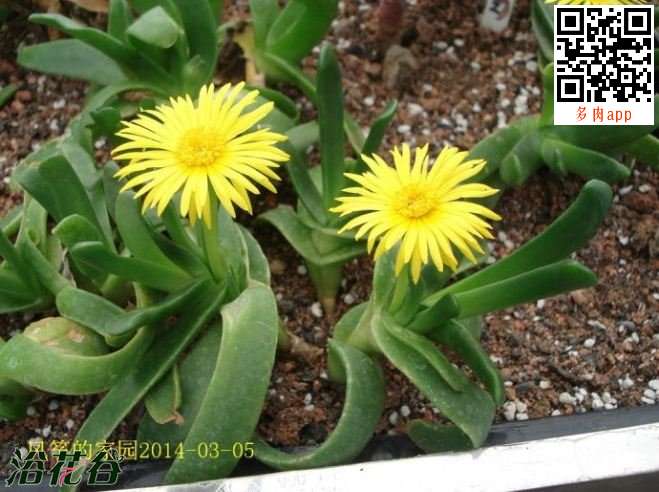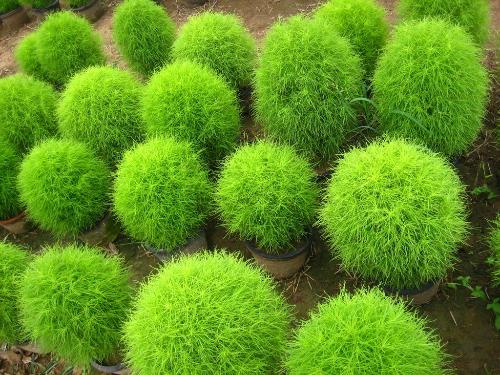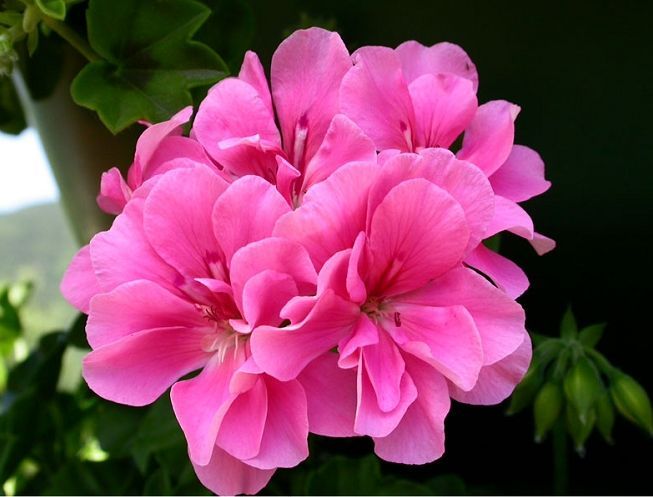The cultivation of Buddha's palm
Buddha palm is a perennial herb, which opens in the sunny afternoon and closes at night, so that the day opens and the night closes for about 7 days. In case of rainy days or insufficient light in the cultivation place, it is difficult to open. It can be illuminated by human light and will open normally. Plants are cross-pollinated.
The plants of Buddha palm are easy to grow in groups. After raising a large group, the number of desquamated heads will be significantly reduced in the coming year, at this time, the plant can split, separate-clump-cluster small communities, so that nutrients will be resupplied, and the heads will gradually return to normal, dormant in summer and growing in other seasons. The peeling period of bergamot is the continuous growth of new leaves, the old leaves slowly dry up, nutrients are provided to new plants, new plant leaves and old leaves can grow at the same time, 3 to 4 pairs of leaves grow all the year round, and new leaves begin to sprout in early spring. the old leaves slowly withered.

The cultivation plant material of Buddha palm is mainly permeable and breathable, this variety is not sun-resistant, it must be sunshaded in summer. Lubao peeling period can be properly watered, this variety usually dry point and then water, otherwise easy to rot roots, semi-woody stem is relatively thick, dry and thoroughly watered during the growth period, do not soak the basin. The whole summer sunshade, put in the bright and ventilated scattered light, summer dormancy period to give as little water as possible, more will rot. The water supply can be restored after the autumn temperature comes down, step by step. If the plant is full, it does not need to be rehydrated. If it is found that the leaves are a little weak, it needs to be rehydrated. It is necessary to avoid frostbite caused by too low temperature in winter. There is no problem when the basin soil is dry at minus 3 degrees. There is a big difference between the north and the south, and flower lovers should breed according to their own environment. The propagation of Buddha palm can be sown or ramet. The function of Buddha's palm the culture method of Buddha's palm
Buddha's palm, also known as glossy flower, is a succulent plant. Buddha palm, originally from South Africa, is cultivated all over the world. Palms very short, fleshy ligulate, opposite 2-lobed, about 10cm long, 2-3 wide, bright green, smooth and glossy. Ye Duan slightly reversed outward, the shape of the plant like bergamot. Flowers bloom in autumn and winter, the flowers are drawn from the leaves, and the Corolla is golden. Is a perennial succulent plant. It is warm in winter and cool and dry in summer. Because of its fleshy leaves about 9 cm long, the leaf color is bright green, the leaf surface is smooth and transparent, the leaf clasping wheel is born on the short stem, which is very similar to the bergamot shape. Morphological characteristics of bergamot: the stem is short or absent. The leaves are fleshy, tongue-shaped, bright green, smooth and glossy, and the leaf ends are slightly reversed outward. It blossoms in autumn and winter, and the flowers are drawn from the leaves, with short pedicels and golden yellow. Its fleshy leaves are green, translucent and glossy, with golden flowers.
Bergamot is native to South Africa, an arid region with warm winters and cool summers, and is cultivated all over the world. The suitable temperature for the growth of bergamot was 18-22 ℃. When the temperature exceeded 30 ℃, the plant grew slowly and showed semi-dormancy. The overwintering temperature must be kept above 10 ℃. It is suitable for the growth of fertile sandy loam with good drainage.
Buddha palm in the current home is also a lot of breeds, why there are so many people in breeding? What kind of function does it have? What kind of breeding methods are there when breeding? Next, let's take a look.
The function of matching Buddha's Palm with Home style
Buddha's palm, also known as glossy flower, is originally from South Africa and is cultivated all over the world. Belongs to the succulent plant, because its succulent leaf is about 6 cm long, the leaf surface is smooth and transparent, the leaf clasping wheel is born on the short stem, very similar to the bergamot shape.
The leaves of bergamot are bright green, the leaves are smooth and transparent, and the leaf clasping wheel is born on a short stem and looks like a bergamot, so many people like to raise bergamot palms at home. Placing Buddha palms in the home can beautify the environment of the home. Buddha's palm is small and lovely, does not take up too much space, and is convenient for breeding. Raising Buddha's palm next to the computer can also absorb radiation, relax the eyes and protect eyesight.
It should be noted that the Buddha's palm is not suitable for the bedroom, it is mostly used to decorate the study, living room desk and coffee table, which is related to its growth conditions, warm in winter, cool and dry in summer, the appropriate temperature for growth is 18-22 ℃, when the temperature exceeds 30 ℃, the plant grows slowly and shows a semi-dormant state, respiration produces more carbon dioxide, which is not good for sleep, and the general bedroom should not put Buddha's palm.
The cultivation plant material of Buddha palm is mainly permeable and breathable, this variety is not sun-resistant, it must be sunshaded in summer. Lubao peeling period can be properly watered, this variety usually dry point and then water, otherwise easy to rot roots, semi-woody stem is relatively thick, dry and thoroughly watered during the growth period, do not soak the basin. The whole summer sunshade, put in the bright and ventilated scattered light, summer dormancy period to give as little water as possible, more will rot. The water supply can be restored after the autumn temperature comes down, step by step. If the plant is full, it does not need to be rehydrated. If it is found that the leaves are a little weak, it needs to be rehydrated. It is necessary to avoid frostbite caused by too low temperature in winter. There is no problem when the basin soil is dry at minus 3 degrees.
The fengshui function of Buddha's palm
Bergamot is a succulent plant belonging to the genus Glottiphyllumuncatum of the family Amygdaceae. It is named because its fleshy leaves are 6-12 cm long, with slightly curled tongue at the end, bright green leaves, smooth and transparent leaves, and leaves clasping whorls on short stems, much like bergamot.
Bergamot is native to South Africa, an arid region with warm winters and cool summers, and is cultivated all over the world. Stem short or absent, opposite 2-lobed, about 7cm long, bright green, smooth and glossy, leaf tip slightly reversed outward. It blossoms in autumn and winter, and the flowers are drawn from the leaves, with short pedicels and golden yellow. It is warm in winter, cool and dry in summer, and the plant grows slowly and semi-dormant. The overwintering temperature must be kept above 10 ℃. It is suitable for the growth of fertile sandy loam with good drainage. Buddha palm leaves are very short, fleshy ligulate, opposite 2-lobed, about 7cm long, 2-3 wide, bright green, smooth and glossy. Ye Duan slightly reversed outward, the shape of the plant like bergamot. Flowers bloom in autumn and winter, the flowers are drawn from the leaves, and the Corolla is golden.
Bergamot leaves are thick and juicy, green and transparent, shaped like jade, elegant and chic. Blooming in the first month of winter, the flowers are golden, burning and dazzling, and Gufen is lovely. Buddha palm suitable for potted plants, display in the desk, windowsill, several cases, small and exquisite, very elegant.
The role of Buddha's palm in centering at home
Buddha's palm, also known as glossy flower, is native to South Africa and is cultivated all over the world. Palms very short, fleshy ligulate, opposite 2-lobed, about 10cm long, 2-3 wide, bright green, smooth and glossy. Succulent plants are often plants that metabolize sedum acid. Their stomata are closed during the day. They exchange gas at night, release oxygen and absorb carbon dioxide, and store them for photosynthesis during the day. The thick leaves are conducive to storing more water and air, which can purify the air.
The leaves of bergamot are bright green, the leaves are smooth and transparent, and the leaf clasping wheel is born on a short stem and looks like a bergamot, so many people like to raise bergamot palms at home. Placing Buddha palms in the home can beautify the environment of the home. Buddha's palm is small and lovely, does not take up too much space, and is convenient for breeding. Raising Buddha's palm next to the computer can also absorb radiation, relax the eyes and protect eyesight.
The culture method of Buddha palm
Bergamot is a succulent plant, because its succulent leaves are about 6 cm long, the leaves are smooth and transparent, and the leaves are born on the short stem, which is very similar to the bergamot shape. The palm of Buddha palm is ramet or sowed and propagated. Ramet is generally carried out in combination with changing pots in spring, and the old plants are cut into several clumps and planted in a separate pot. Bergamot palm is produced in southern Africa. It likes warm, humid, sunny environment and is afraid of cold. The suitable temperature for growth is 18 ℃ to 22 ℃. Lax requirements for soil, avoid consolidation and stagnant water, sandy loam with good drainage is the best. It is warm in winter, cool and dry in summer, and the plant grows slowly and semi-dormant. It is suitable for the growth of fertile sandy loam with good drainage.
Fertilization is applied once a month during the growing period of bergamot. When the summer temperature is high, the basin soil should be slightly dry. Such as high temperature and humidity, stems and leaves are easy to rot. Autumn growth is the most exuberant, watering should be more, after winter, the temperature drops, growth slows down, watering decreases accordingly. Summer high temperature season, should be properly shaded, to create a well-ventilated, cool semi-overcast environment, so that it can safely spend the summer. If it grows vigorously in autumn, nitrogen fertilizer should not be too much, otherwise it is easy to lead to plant overgrowth and rotten leaves, in addition, when pouring organic fertilizer, do not splash down on the leaves, so as not to cause disease spots and rot.
The above is for you to share the role of Buddha palm and breeding methods, do you understand? Please pay attention to more household plants.
- Prev

How to grow the skin of the earth?
1. Sowing seedlings can be direct seeded or seedling transplanting. Direct seeding in the open field can be carried out in early April, and sufficient base fertilizer should be applied before sowing. Hole sowing, strip sowing or withdrawal sowing can be done. The seedlings in the protected field can be sown from the first ten days to the middle of March, the diameter of the seeds covered with soil is 3-4 times, and the seedlings emerge after 6-7 days.
- Next

Winter management and pruning and shaping of pelargonium
Geraniums like temperature and are afraid of cold. Special attention should be paid to preventing cold and freezing in winter. When raising geraniums in the northern region, the pot plants should be moved indoors and placed in front of sunny windows when Frosts Descent arrives, so that they can fully receive the light. If the light is not enough, the plant is easy to grow, which affects the formation of flower buds.
Related
- Fuxing push coffee new agricultural production and marketing class: lack of small-scale processing plants
- Jujube rice field leisure farm deep ploughing Yilan for five years to create a space for organic food and play
- Nongyu Farm-A trial of organic papaya for brave women with advanced technology
- Four points for attention in the prevention and control of diseases and insect pests of edible fungi
- How to add nutrient solution to Edible Fungi
- Is there any good way to control edible fungus mites?
- Open Inoculation Technology of Edible Fungi
- Is there any clever way to use fertilizer for edible fungus in winter?
- What agents are used to kill the pathogens of edible fungi in the mushroom shed?
- Rapid drying of Edible Fungi

